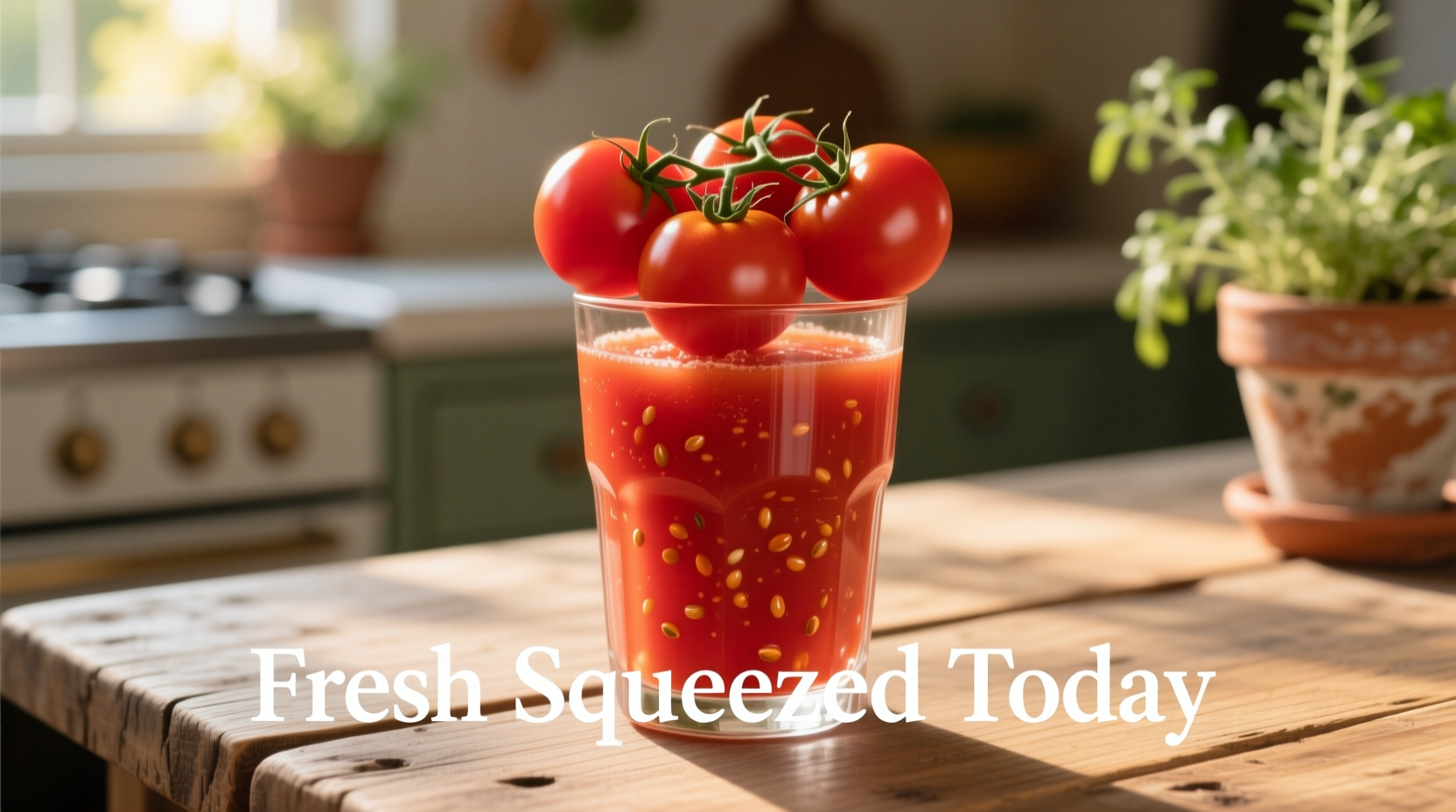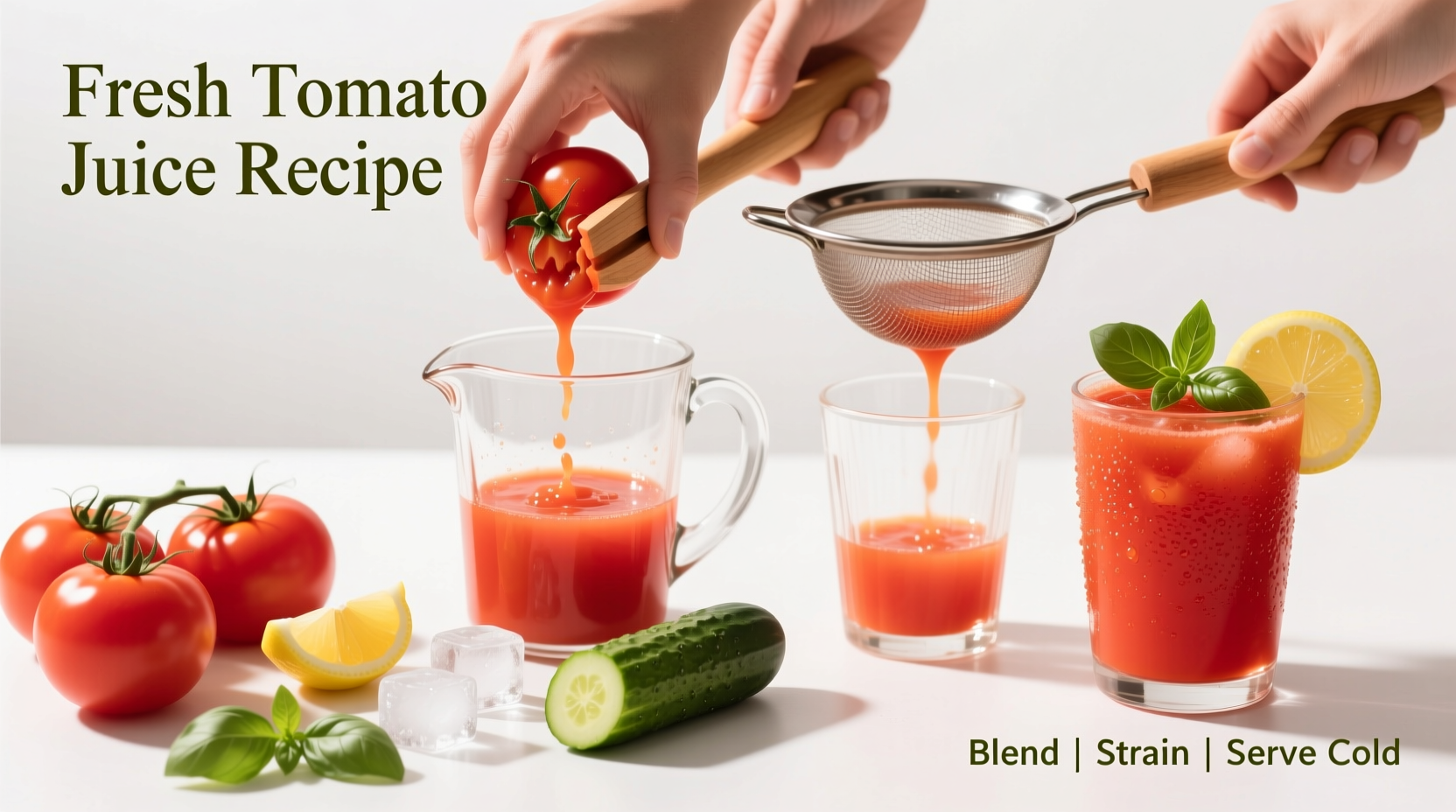Creating delicious homemade tomato juice is simpler than you might think, and the results far surpass store-bought versions in both flavor and nutritional value. Unlike commercial products that often contain added sugars, sodium, and preservatives, fresh tomato juice lets you control every ingredient while maximizing health benefits. The key lies in selecting the right tomatoes and understanding the minimal processing needed to preserve nutrients while enhancing flavor.
Why Homemade Tomato Juice Beats Store-Bought
Commercial tomato juices typically undergo extensive processing that degrades heat-sensitive nutrients like vitamin C while adding unnecessary ingredients. When you make juice at home, you retain up to 30% more lycopene—the powerful antioxidant responsible for tomatoes' red color and numerous health benefits—especially when you lightly cook the tomatoes first. Research from the National Institutes of Health confirms that cooking tomatoes actually increases lycopene bioavailability by breaking down cell walls.
| Tomato Variety | Best For Juice? | Lycopene Content (mg/100g) | Flavor Profile |
|---|---|---|---|
| Roma (Plum) | ✓✓✓ Best choice | 4.3-5.1 | Rich, concentrated, less watery |
| Beefsteak | ✓✓ Good | 3.8-4.5 | Balanced sweet-tart, more liquid |
| Cherry | ✓ Acceptable | 3.5-4.0 | Sweet, higher sugar content |
| Grape | ✗ Not recommended | 2.9-3.4 | Very watery, less flavorful |
USDA Agricultural Research Service data shows Roma tomatoes contain significantly higher lycopene concentrations and less water content, making them ideal for concentrated juice without excess pulp.
Your Tomato Juice Equipment Checklist
You don't need expensive machinery to make excellent tomato juice. Here's what you'll actually use:
- Medium saucepan (stainless steel or enameled cast iron)
- Blender or food processor (any standard model works)
- Fine-mesh strainer (essential for smooth texture)
- Wooden spoon (for gentle stirring)
- Glass jars (for storage)
Avoid citrus juicers or wheatgrass extractors—they're designed for different produce textures and will yield disappointing results with tomatoes.
Step-by-Step: Crafting Perfect Tomato Juice
Step 1: Select and Prepare Tomatoes
Choose 2 pounds of ripe Roma tomatoes (about 6-8 medium). Look for deep red color with no green patches, indicating full ripeness and maximum lycopene development. Wash thoroughly, then remove stems and any blemishes. Do not peel—the skins contain valuable fiber and nutrients that transfer to your juice.
Step 2: Gentle Cooking Process
Place tomatoes in your saucepan over medium heat. As they warm, they'll release natural juices. Cook for 8-10 minutes, stirring occasionally with your wooden spoon, until tomatoes become soft and pulpy but not completely broken down. This gentle heating (160-180°F) preserves nutrients while making extraction easier—unlike boiling which degrades vitamin C.
Step 3: Blending and Straining
Transfer cooked tomatoes to your blender. Pulse 5-6 times until coarsely chopped—over-blending creates foam and incorporates too much air. Pour mixture through your fine-mesh strainer into a clean bowl, using the back of a spoon to press liquid through while leaving seeds and tough fibers behind.
Step 4: Flavor Enhancement (Optional)
While traditional tomato juice stands beautifully on its own, consider these professional touches:
- Pinch of sea salt (enhances natural sweetness)
- 1-2 tsp fresh lemon juice (brightens flavor)
- Small celery stalk (adds complexity without overpowering)
- 1 garlic clove (for savory variation)
Add any enhancements during the cooking phase to allow flavors to meld properly.

When Homemade Makes Sense: Context Boundaries
While homemade tomato juice offers superior quality, consider these context boundaries:
- Seasonal advantage: Peak tomato season (July-September) yields the best results; off-season tomatoes lack flavor depth
- Time investment: Requires 20 minutes active time versus instant store-bought
- Nutritional priority: Ideal when avoiding preservatives or controlling sodium intake
- Volume needs: Not practical for large quantities without commercial equipment
During winter months when tomatoes are less flavorful, consider freezing summer batches or using high-quality canned tomatoes from brands like Muir Glen that use minimal processing.
Troubleshooting Common Issues
Problem: Juice is too watery
Solution: Use Roma tomatoes exclusively and avoid adding water during cooking. If already prepared, simmer strained juice for 5-7 minutes to reduce and concentrate flavors.
Problem: Bitter aftertaste
Solution: This usually comes from green patches on tomatoes. Always select fully ripe specimens and remove any green areas before cooking. A pinch of sugar can counteract mild bitterness.
Problem: Separation in storage
Solution: Natural separation occurs. Simply shake gently before serving. For longer stability, add 1 tsp lemon juice per quart which helps maintain emulsion.
Preservation Techniques for Maximum Freshness
Properly stored, your homemade tomato juice maintains peak quality for:
- Refrigeration: 5-7 days in airtight glass container (FDA recommends this timeframe for fresh vegetable juices)
- Freezing: 8-10 months in freezer-safe containers with 1-inch headspace
- Canning: 12-18 months using proper pressure canning methods
Never attempt water-bath canning for tomato juice alone—tomatoes' pH requires pressure canning for safety. The National Center for Home Food Preservation provides detailed guidelines for safe preservation.
Nutritional Powerhouse: What Makes Tomato Juice Special
One cup (240ml) of homemade tomato juice delivers remarkable nutrition:
- Lycopene: 22-28 mg (significantly higher than store-bought due to minimal processing)
- Vitamin C: 45% of daily value
- Potassium: 15% of daily value
- Vitamin K: 12% of daily value
- Natural electrolytes for hydration
Unlike commercial versions that often contain 500+ mg of sodium per serving, your homemade version contains just 20-30 mg naturally—making it ideal for blood pressure management.
Three Professional Variations to Try
Classic Morning Boost
Add 1/4 tsp celery seed and a dash of black pepper during cooking. The pepper enhances lycopene absorption while celery seed adds complexity without overpowering.
Mediterranean Detox Version
Include 1/2 cucumber and 5 basil leaves during blending. This variation increases hydration and adds chlorophyll benefits while maintaining tomato's dominant flavor profile.
Spicy Immunity Elixir
Simmer with 1/4 tsp turmeric, 1/8 tsp cayenne, and 1-inch fresh ginger. These additions create a synergistic effect that boosts the anti-inflammatory properties significantly.
Maximizing Your Tomato Juice Experience
For optimal nutrient absorption, enjoy your tomato juice with a small amount of healthy fat like avocado or olive oil—the lycopene in tomatoes is fat-soluble. Drink within 30 minutes of preparation for maximum vitamin C content, as this nutrient degrades quickly once exposed to air. Consider making smaller batches more frequently rather than large quantities that lose nutritional value during storage.











 浙公网安备
33010002000092号
浙公网安备
33010002000092号 浙B2-20120091-4
浙B2-20120091-4